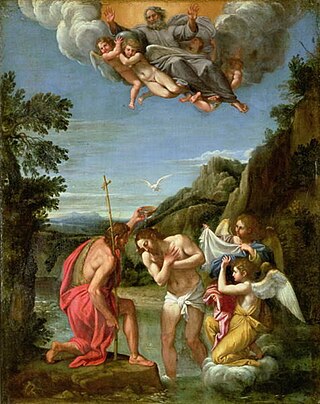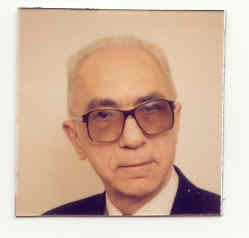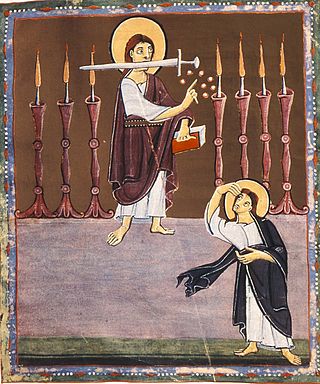
Adoptionism, also called dynamic monarchianism, is an early Christian nontrinitarian theological doctrine, subsequently revived in various forms, which holds that Jesus was adopted as the Son of God at his baptism, his resurrection, or his ascension. How common adoptionist views were among early Christians is debated, but it appears to have been most popular in the first, second, and third centuries. Some scholars see adoptionism as the belief of the earliest followers of Jesus, based on the epistles of Paul and other early literature. However, adoptionist views sharply declined in prominence in the fourth and fifth centuries, as Church leaders condemned it as a heresy.

Christ, used by Christians as both a name and a title, unambiguously refers to Jesus. It is also used as a title, in the reciprocal use "Christ Jesus", meaning "the Messiah Jesus", and independently as "the Christ". The Pauline epistles, the earliest texts of the New Testament, often refer to Jesus as "Christ Jesus" or "Christ".

In Christianity, Christology, translated from Greek as 'the study of Christ', is a branch of theology that concerns Jesus. Different denominations have different opinions on questions such as whether Jesus was human, divine, or both, and as a messiah what his role would be in the freeing of the Jewish people from foreign rulers or in the prophesied Kingdom of God, and in the salvation from what would otherwise be the consequences of sin.

Jacques Dupuis was a Belgian Jesuit priest and theologian. He spent several decades in India and taught at the Pontifical Gregorian University in Rome.

The resurrection of Jesus is the Christian belief that God raised Jesus from the dead on the third day after his crucifixion, starting – or restoring – his exalted life as Christ and Lord. According to the New Testament writing, Jesus was firstborn from the dead, ushering in the Kingdom of God. He appeared to his disciples, calling the apostles to the Great Commission of forgiving sin and baptizing repenters, and ascended to Heaven.

In Christianity, Jesus is the Son of God as written in the Bible's New Testament, and in mainstream Christian denominations he is God the Son, the second Person in the Trinity. Christians believe him to be the Jewish messiah prophesied in the Hebrew Bible. Through Jesus's crucifixion and resurrection, God reputedly offers humans salvation and eternal life, with Jesus's death atoning for all sin, thus making humanity right with God.

Karl Rahner was a German Jesuit priest and theologian who, alongside Henri de Lubac, Hans Urs von Balthasar, and Yves Congar, is considered to be one of the most influential Roman Catholic theologians of the 20th century. He was the brother of Hugo Rahner, also a Jesuit scholar.
Communicatio idiomatum is a Christological concept about the interaction of deity and humanity in the person of Jesus Christ. It maintains that in view of the unity of Christ's person, his human and divine attributes and experiences might properly be referred to his other nature so that the theologian may speak of "the suffering of God".
Liberal Christianity, also known as Liberal Theology and historically as Christian Modernism, is a movement that interprets Christian teaching by taking into consideration modern knowledge, science and ethics. It emphasizes the importance of reason and experience over doctrinal authority. Liberal Christians view their theology as an alternative to both atheistic rationalism and theologies based on traditional interpretations of external authority, such as the Bible or sacred tradition.
Miaphysitism is the Christological doctrine that holds Jesus, the "Incarnate Word, is fully divine and fully human, in one 'nature' (physis)." It is a position held by the Oriental Orthodox Churches and differs from the Chalcedonian position that Jesus is one "person" in two "natures", a divine nature and a human nature (Dyophysitism).

The Paschal mystery is one of the central concepts of Catholic faith relating to the history of salvation. According to the Compendium of the Catechism of the Catholic Church, "The Paschal Mystery of Jesus, which comprises his passion, death, resurrection, and glorification, stands at the center of the Christian faith because God's saving plan was accomplished once for all by the redemptive death of himself as Jesus Christ." The Catechism states that in the liturgy of the Church "it is principally his own Paschal mystery that Christ signifies and makes present."
Walter Künneth was a German Protestant theologian. During the Nazi era, he was part of the Confessing Church, and in the 1960s took part in the debate around the demands of Rudolf Bultmann to 'de-mythologize' the New Testament as an advocate of a word-oriented interpretation of the Bible. The Walter Künneth Prize is named after him.
Divine presence, presence of God, Inner God, or simply presence is a concept in religion, spirituality, and theology that deals with the ability of a deity to be "present" with human beings, sometimes associated with omnipresence.

The Session of Christ or heavenly session is a Christian doctrine stating that Jesus Christ is seated at the right hand of God the Father in Heaven—the word "session" is an archaic noun meaning "sitting". Although the word formerly meant "the act of sitting down", its meaning is somewhat broader in current English usage, and is used to refer to a sitting for various reasons, such as a teaching session, or a court or council being in session. The New Testament also depicts Jesus as standing and walking in Heaven, but the Session of Christ has special theological significance because of its connection to the role of Christ as King. The Session of Christ is one of the doctrines specifically mentioned in the Apostles' Creed, where "sitteth on the right hand of God the Father Almighty" immediately follows the statement of the Ascension.
Christian theology is the theology of Christian belief and practice. Such study concentrates primarily upon the texts of the Old Testament and of the New Testament, as well as on Christian tradition. Christian theologians use biblical exegesis, rational analysis and argument. Theologians may undertake the study of Christian theology for a variety of reasons, such as in order to:

Christian theology sometimes refers to Jesus using the title Redeemer. This refererences the salvation he accomplished, and is based on the metaphor of redemption, or "buying back". In the New Testament, redemption can refer both to deliverance from sin and to freedom from captivity.

Son of man is an expression in the sayings of Jesus in Christian writings, including the Gospels, the Acts of the Apostles and the Book of Revelation. The meaning of the expression is controversial. Interpretation of the use of "the Son of man" in the New Testament has remained challenging and after 150 years of debate no consensus on the issue has emerged among scholars.
Leo's Tome was a letter sent by Pope Leo I to Flavian of Constantinople, explaining the position of the Papacy in matters of Christology. The text confesses that Christ has two natures, both fully human and fully divine. The letter was a topic of debate at the Council of Chalcedon in 451 being eventually accepted as a doctrinal explanation of the nature of the Person of Christ. The letter was written in response to Flavian, Patriarch of Constantinople, who had excommunicated Eutyches, who also wrote to the Pope to appeal the excommunication.
Gerald Glynn O'Collins is an Australian Jesuit priest and academic. He was a research professor and writer-in-residence at the Jesuit Theological College (JTC) in Parkville, Victoria, and a research professor in theology at St Mary's University College in Twickenham. For more than three decades, he was professor of systematic and fundamental theology at the Pontifical Gregorian University (Rome).

Jesus: A Portrait is a 2008 Christological book by the Australian Jesuit priest and academic Gerald O'Collins.












